2021 MERCEDES-BENZ GLE COUPE steering wheel
[x] Cancel search: steering wheelPage 6 of 525
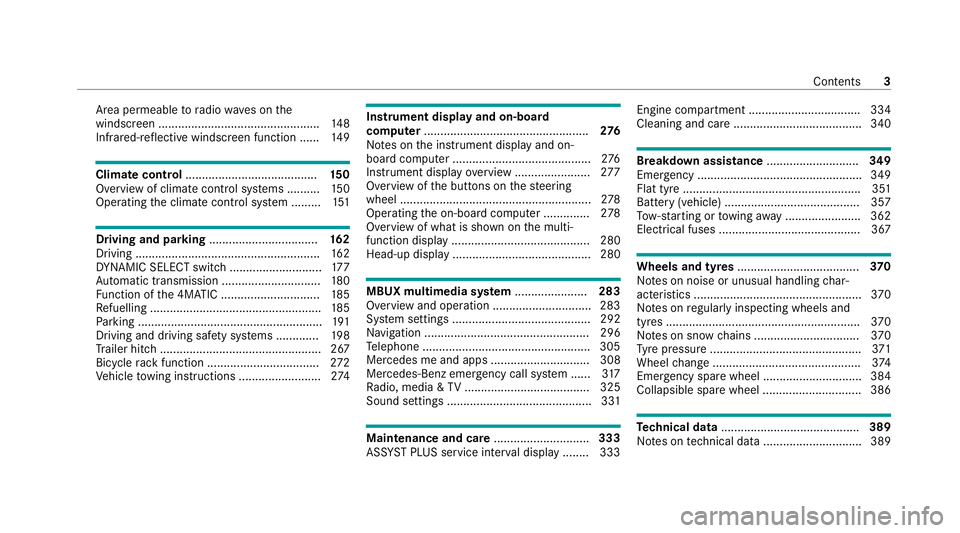
Area pe
rmeable toradio wav es on the
windscreen ................................................ .148
Infrared-reflective windscreen function ...... 14 9Climate control
........................................ 15 0
Overview of climate contro l systems ..........1 50
Operating the climate control sy stem ......... 151 Driving and pa
rking ................................. 16 2
Driving ........................................................ 16 2
DY NA MIC SELECT switch ............................1 77
Au tomatic transmission .............................. 180
Fu nction of the 4MATIC .............................. 185
Re fuelling .................................................... 185
Pa rking ........................................................ 191
Driving and driving sa fety sy stems .............1 98
Tr ailer hit ch................................................. 267
Bicycle rack function .................................. 272
Ve hicle towing instructions ........................ .274 Instrument display and on-board
compu
ter.................................................. 276
No tes on the instrument display and on-
board computer .......................................... 276
Instrument display overview ...................... .277
Overview of the buttons on thesteering
wheel ..........................................................2 78
Operating the on-board computer .............. 278
Overview of what is shown on the multi‐
function display .......................................... 280
Head-up display .......................................... 280 MBUX multimedia sy
stem ...................... 283
Overview and operation .............................. 283
Sy stem settings .......................................... 292
Na vigation .................................................. 296
Te lephone .................................................. .305
Mercedes me and apps .............................. 308
Mercedes-Benz emer gency call sy stem ...... 317
Ra dio, media & TV...................................... 325
Sound settings ............................................ 331 Main
tenance and care ............................. 333
ASS YST PLUS service inter val display ........ 333 Engine compartment .................................. 334
Cleaning and care ......................................
.340 Breakdown assi
stance ............................ 349
Emergency ................................................. .349
Flat tyre ...................................................... 351
Battery (vehicle) ......................................... 357
To w- starting or towing away ....................... 362
Electrical fuses ........................................... 367 Wheels and tyres
..................................... 37 0
No tes on noise or unusual handling char‐
acteristics .................................................. .370
No tes on regular lyinspecting wheels and
tyres .......................................................... .370
No tes on snow chains ................................ 370
Ty re pressure .............................................. 371
Wheel change ............................................ .374
Emergency spare wheel .............................. 384
Collapsible spare wheel .............................. 386 Te
ch nical data .......................................... 389
No tes on tech nical da ta.............................. 389 Contents
3
Page 10 of 525

1
Steering wheel gearshift paddles →
183
2 Combination swit ch →
13 5
3 Instrument display →
277
4 DIRECT SELECT le ver →
180
5 Media display →
283
6 Climate contro l systems →
151
7 002F Hazardwa rning light sy stem →
13 5
8 PASSENGER AIR BAG indicator lamps →
50
9 Glovecompa rtment →
11 7
A Stow age compartment →
11 7
B 0063 Controller forvo lume and switching
sound on/off →
283
00D0 Switches the MBUX multimedia sy stem
on/off →
283
C z Calls up navigation →
285
D | Calls up radio or media →
285
E 002B Calls up thete lephone →
285 F
Swit chpanel for:
ä Individual wheel control →
24 5
0063 Manual gearshifting →
183
¿ AIRMATIC or →
237
¿ E-AC TIVE BODY CONTROL →
24 2
00BB Activating/deactivating ESP ®
→
201
î Downhill Speed Regulation →
218
G ß Calls up favo urites →
285
H y Calls up vehicle functions →
285
I c Active Parking Assist →
261
J DYNA MIC SELECT switch →
178
K Touchpad →
285
L Start/ stop button →
16 3
00D6 ECOstart/ stop function →
174
M Control panel forth e MBUX multimedia sys‐
tem →
278
N Adjusts thesteering wheel manually →
11 0 At
aglance – Cockpit 7
Page 11 of 525
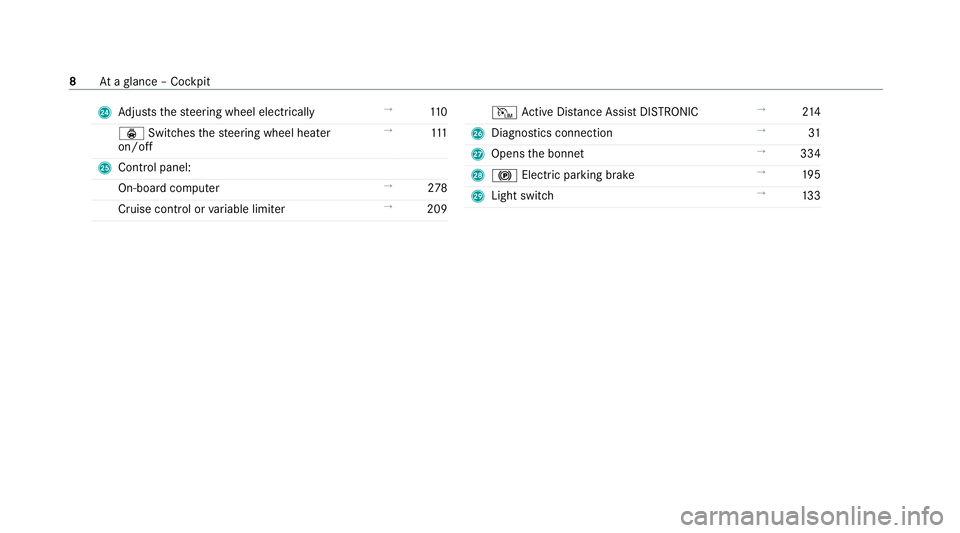
O
Adjusts thesteering wheel electrically →
11 0
ý Switches thesteering wheel heater
on/off →
111
P Control panel:
On-board co mputer →
278
Cruise contro l orvariable limiter →
209 I
Active Dis tance Assi stDISTRONIC →
214
Q Diagno stics connection →
31
R Opens the bonn et →
334
S 0024 Electric parking brake →
19 5
T Light switch →
13 3 8
Ataglance – Cockpit
Page 40 of 525
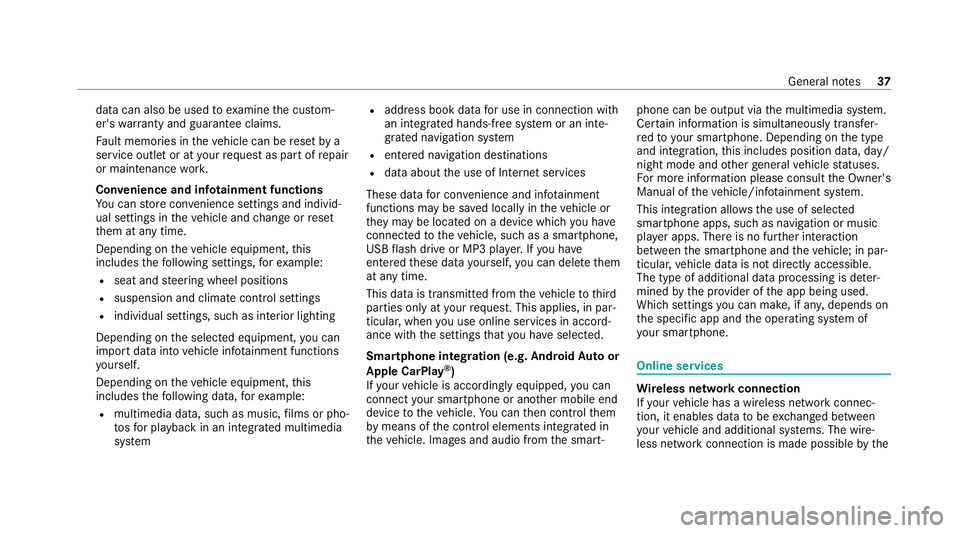
data can also be used
toexamine the cus tom‐
er's warranty and guarantee claims.
Fa ult memories in theve hicle can be reset by a
service outlet or at your requ est as part of repair
or maintenance work.
Con venience and inf otainment functions
Yo u can store con venience settings and individ‐
ual settings in theve hicle and change or reset
th em at any time.
Depending on theve hicle equipment, this
includes thefo llowing settings, forex ample:
R seat and steering wheel positions
R suspension and climate control settings
R individual settings, such as interior lighting
Depending on the selected equipment, you can
import data into vehicle inf otainment functions
yo urself.
Depending on theve hicle equipment, this
includes thefo llowing data, forex ample:
R multimedia data, such as music, films or pho‐
to sfo r playback in an integrated multimedia
sy stem R
address book data for use in connection with
an integrated hands-free sy stem or an inte‐
grated navigation sy stem
R entered navigation destinations
R data about the use of Internet services
These data for con venience and inf otainment
functions may be sa ved locally in theve hicle or
th ey may be located on a device which you ha ve
connected totheve hicle, such as a smartphone,
USB flash drive or MP3 pla yer.If yo u ha ve
entered these data yourself, you can dele tethem
at any time.
This data is transmit ted from theve hicle tothird
parties only at your requ est. This applies, in par‐
ticular, when you use online services in accord‐
ance with the settings that you ha veselected.
Smartphone integ ration (e.g. Android Autoor
Apple CarPlay ®
)
If yo ur vehicle is accordingly equipped, you can
connect your smartphone or ano ther mobile end
device totheve hicle. You can then control them
by means of the control elements integrated in
th eve hicle. Images and audio from the smart‐ phone can be output via
the multimedia sy stem.
Cer tain information is simultaneously transfer‐
re dto yo ur smartphone. Depending on the type
and integration, this includes position data, day/
night mode and other general vehicle statuses.
Fo r more information please consult the Owner's
Manual of theve hicle/inf otainment sy stem.
This integration allo wsthe use of selected
smartphone apps, such as navigation or music
pla yer apps. There is no fur ther interaction
between the smartphone and theve hicle; in par‐
ticular, vehicle data is not directly accessible.
The type of additional data processing is de ter‐
mined bythe pr ovider of the app being used.
Which settings you can make, if an y,depends on
th e specific app and the operating sy stem of
yo ur smartphone. Online services
Wi
reless network connection
If yo ur vehicle has a wireless network connec‐
tion, it enables data tobe exc hanged between
yo ur vehicle and additional sy stems. The wire‐
less network connection is made possible bythe Gene
ral no tes 37
Page 47 of 525
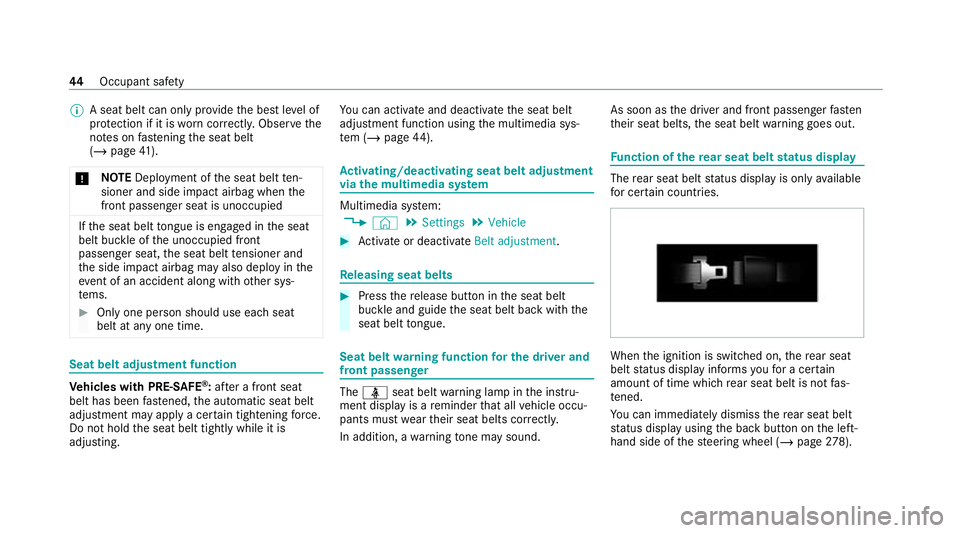
%
A seat belt can only pr ovide the best le vel of
pr otection if it is worncor rectl y.Obser vethe
no tes on fastening the seat belt
(/ page 41).
* NO
TEDeployment of the seat belt ten‐
sioner and side impact airbag when the
front passenger seat is unoccupied If
th e seat belt tongue is engaged in the seat
belt buckle of the unoccupied front
passenger seat, the seat belt tensioner and
th e side impact airbag may also deploy in the
ev ent of an accident along with other sys‐
te ms. #
Only one person should use each seat
belt at any one time. Seat belt adjustment function
Ve
hicles with PRE-SAFE ®
:af te r a front seat
belt has been fastened, the automatic seat belt
adjustment may apply a cer tain tigh tening forc e.
Do not hold the seat belt tightly while it is
adjusting. Yo
u can activate and deactivate the seat belt
adjustment function using the multimedia sys‐
te m (/ page44). Ac
tivating/deactivating seat belt adjustment
via the multimedia sy stem Multimedia sy
stem:
4 © 5
Settings 5
Vehicle #
Activate or deacti vate Belt adjustment. Re
leasing seat belts #
Press there lease button in the seat belt
buckle and guide the seat belt back with the
seat belt tongue. Seat belt
warning function for the driver and
front passen ger The
00E9 seat belt warning lamp in the instru‐
ment display is a reminder that all vehicle occu‐
pants must weartheir seat belts cor rectly.
In addition, a warning tone may sound. As soon as
the driver and front passenger fasten
th eir seat belts, the seat belt warning goes out. Fu
nction of there ar seat belt status display The
rear seat belt status display is on lyavailable
fo r cer tain countries. When
the ignition is switched on, there ar seat
belt status display informs youfo r a cer tain
amount of time which rear seat belt is not fas‐
te ned.
Yo u can immediately dismiss there ar seat belt
st atus display using the back button on the left-
hand side of thesteering wheel (/ page278). 44
Occupant saf ety
Page 48 of 525
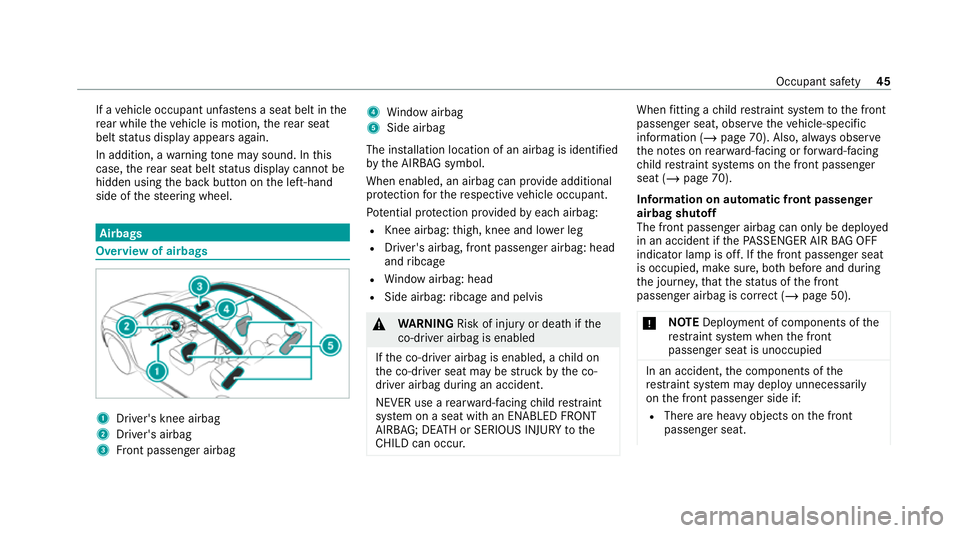
If a
vehicle occupant unfas tens a seat belt in the
re ar while theve hicle is motion, there ar seat
belt status display appears again.
In addition, a warning tone may sound. In this
case, there ar seat belt status display cannot be
hidden using the back button on the left-hand
side of thesteering wheel. Airbags
Overview of airbags
1
Driver's knee airbag
2 Driver's airbag
3 Front passenger airbag 4
Window airbag
5 Side airbag
The ins tallation location of an airbag is identified
by the AIRB AGsymbol.
When enabled, an airbag can pr ovide additional
pr otection forth ere spective vehicle occupant.
Pot ential pr otection pr ovided byeach airbag:
R Knee airbag: thigh, knee and lo wer leg
R Driver's airbag, front passenger airbag: head
and ribcage
R Window airbag: head
R Side airbag: ribcage and pelvis &
WARNING Risk of injury or death ifthe
co-driver airbag is enabled
If th e co-driver airbag is enabled, a child on
th e co-driver seat may be stru ck bythe co-
driver airbag during an accident.
NEVER use a rear wa rd-facing child restra int
sy stem on a seat with an ENABLED FRONT
AIRB AG; DEAT H or SERIOUS INJU RYtothe
CH ILD can occur. When
fitting a child restra int sy stem tothe front
passenger seat, obser vetheve hicle-specific
information (/ page 70). Also, alw ays obser ve
th e no tes on rear wa rd-facing or forw ard-facing
ch ild restra int sy stems on the front passenger
seat (/ page 70).
Information on automatic front passenger
airbag shutoff
The front passenger airbag can only be deplo yed
in an accident if thePA SSENGER AIR BAG OFF
indicator lamp is off. If the front passenger seat
is occupied, make sure, bo thbefore and during
th e journe y,that thest atus of the front
passenger airbag is cor rect (/ page 50).
* NO
TEDeployment of components of the
re stra int sy stem when the front
passenger seat is unoccupied In an accident,
the components of the
re stra int sy stem may deploy unnecessarily
on the front passenger side if:
R There are heavy objects on the front
passenger seat. Occupant saf
ety45
Page 49 of 525

R
The seat belt tongue is engaged in the
seat belt buckle of the front passenger
seat and the front passenger seat is
unoccupied. #
Stow objects in a suitable place. #
Only one person should use each seat
belt at any one time. Depending on
the de tected accident situation,
th e window airbag on the front passenger side
may deplo y.The airbag is deplo yedre ga rdless of
whe ther the front passenger seat is occupied. Pr
otective capacity of the airbags Depending on
the accident situation, an airbag
may supplement the pr otection of fere dby a cor‐
re ctly fastened seat belt. &
WARNING Risk of injury or death dueto
an incor rect seat position
If yo u deviate from the cor rect seat position,
th e airbag cann otper form its intended pro‐
te ctive function. Each
vehicle occupant must make sure of the
fo llowing:
R Fasten seat belts cor rectl y.Pregnant
wo men must take particular care to
ensure that the lap belt ne ver lies across
th e abdomen.
R Adopt the cor rect seat position and keep
as faraw ay as possible from the airbags.
R Obser vethefo llowing information. #
Alw ays make sure that there are no
objects between the airbag and vehicle
occupant. To
avo idtherisks resulting from the deployment
of an airbag, each vehicle occupant must
obser vethefo llowing information in particular:
R Before starting your journe y,adjust your seat
co rrectly; the driver's seat and front
passenger seat should be mo ved as far back
as possible.
When doing so, alw ays obser vethe informa‐
tion on the cor rect driver's seat position
(/ page 99). R
Only hold thesteering wheel bythesteering
wheel rim. This allows the airbag tobe fully
deplo yed.
R Alw ays lean against the seat backrest when
th eve hicle is in motion. Do not lean forw ards
or against the door or side windo w.You may
ot herwise be in the deployment area of the
airbags.
R The occupants must alw ayske ep their feet
on thefloor. Do not put your feet on the
cockpit, forex ample. Your feet may other‐
wise be in the deployment area of the airbag.
R Ifch ildren are tra velling in theve hicle,
obser vethe additional no tes (/ page 55).
R Alw aysstow and secure objects cor rectly.
Objects in theve hicle interior may pr event an
airbag from functioning cor rectly. Each vehicle
occupant must alw ays make sure of thefo llow‐
ing in particular:
R There are no people, animals or objects
between theve hicle occupants and an air‐
bag. 46
Occupant saf ety
Page 102 of 525
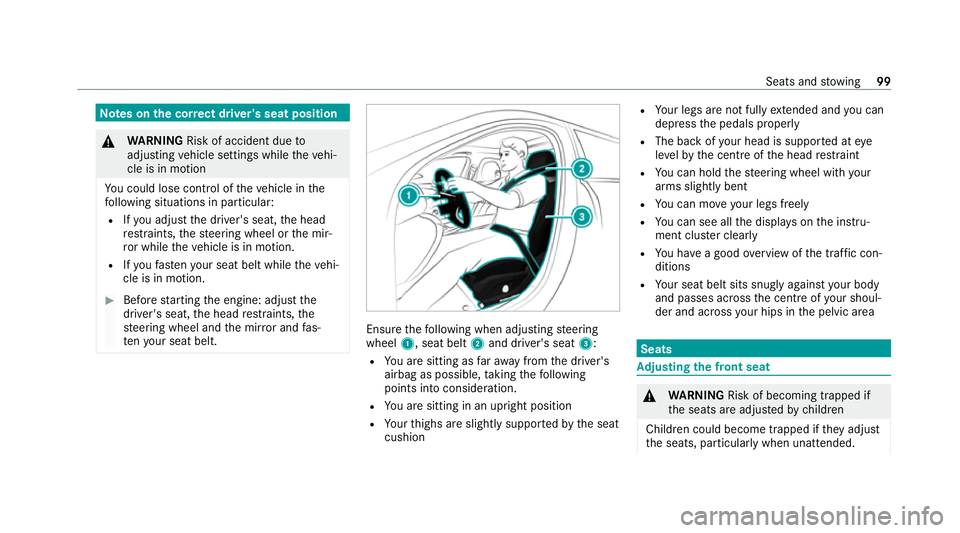
Note
s onthe cor rect driver's seat position &
WARNING Risk of accident due to
adjusting vehicle settings while theve hi‐
cle is in motion
Yo u could lose cont rol of theve hicle in the
fo llowing situations in particular:
R Ifyo u adjust the driver's seat, the head
re stra ints, thesteering wheel or the mir‐
ro r while theve hicle is in motion.
R Ifyo ufast enyour seat belt while theve hi‐
cle is in motion. #
Before starting the engine: adjust the
driver's seat, the head restra ints, the
st eering wheel and the mir ror and fas‐
te nyo ur seat belt. Ensure
thefo llowing when adjusting steering
wheel 1, seat belt 2and driver's seat 3:
R You are sitting as faraw ay from the driver's
airbag as possible, taking thefo llowing
points into consideration.
R You are sitting in an upright position
R Your thighs are slight lysuppor tedby the seat
cushion R
Your legs are not fully extended and you can
depress the pedals properly
R The back of your head is suppo rted at eye
le ve lby the cent reofthe head restra int
R You can hold thesteering wheel with your
arms slightly bent
R You can mo veyour legs freely
R You can see all the displa yson the instru‐
ment clus ter clea rly
R You ha vea good overview of the tra ffic con‐
ditions
R Your seat belt sits snug lyagainst your body
and passes across the cent reofyour shoul‐
der and across your hips in the pelvic area Seats
Ad
justing the front seat &
WARNING Risk of becoming trapped if
th e seats are adjus tedby children
Children could become trapped if they adjust
th e seats, particular lywhen unat tended. Seats and
stowing 99